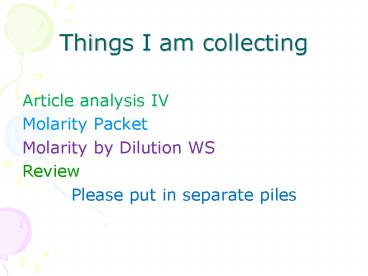Things I am collecting PowerPoint PPT Presentation
1 / 31
Title: Things I am collecting
1
Things I am collecting
- Article analysis IV
- Molarity Packet
- Molarity by Dilution WS
- Review
- Please put in separate piles
2
Chem Matters
- Chem Matters Articles by Topic
- Solutions
- Quest for a clean drink
- Salting Roads
- Forensics of Blood
3
Equilibrium
- Big name-- easy idea!
4
Chemical Reactions
- You have a system made up of a bunch of
molecules. - Energy is absorbed to break bonds.
- Molecules combine to form new compounds
(releasing energy).
5
Collision Theory
- Molecules must bang together
- with enough energy (activation energy)
- in the right orientation (just the right way)
- for a reaction to occur
6
Potential Energy Diagram
- Ea activation energy. This is the minimum
amount of energy necessary to make the reaction
happen. - Top of the hill
- Activated complex- (transition state)
7
Reverse Reactions
- Once you have a bunch of the new compound the
new compound wants to go back to being the old
compound.
8
In short- the products become reactants and have
to find a way to get back up over the hill
9
Put those two ideas together and you have
EQUILIBRIUM
- 1. Reactants combine to make a products.
- 2. Products like to break apart and turn back
into the reactants. - 3. There is a point where the two reactions
happen and you can't tell that any reactions are
occurring (equilibrium).
10
Think about a swimming pool.(Phase Changes)
- What happens in the summer when it is really hot?
- What happens when it is raining?
- What is happening when the level of the water
doesnt change?
11
In a closed system
- Net transfer of molecules from the liquid state
to the vapor state - The amount of the substance in the vapor state
becomes constant - The equilibrium state is achieved.
12
Rate of Reaction
- Depends on the properties of the reactants (size
and reactivity) - Depends on the conditions of the system
13
Factors affecting Reaction RateWrite about how
each affects the kinetic energy of the reactants.
- Temperature
- Concentration
- Particle Size (surface area)
- Agitation
14
Iodine/ Vit C demo
15
Particle Size Demo
16
So.. What exactly is equal at equilibrium??
- Rateforward rxn Ratereverse rxn
- Law of Chemical Equilibrium
- There is no net change in the actual amount of
the compounds. - Be careful!! The rate is equal
- the amount is probably not equal!!
17
Changes with time in the rates of reactions.
- This looks the same no matter what the products
and reactants are!!
18
Equilibrium Position
- The equilibrium position indicates the relative
concentration of the products and reactants at
equilibrium. - A B -----gt AB
- Can also be the reverse reaction.
- AB -----gt A B
- We draw a wacky double arrow shows to show what
side of the equation is favored (has more). - A B AB
- Size Matters!!
19
LeChateliers Principle
- If a change is imposed on a system at
equilibrium, the position of the equilibrium will
shift in a direction will reduce the change.
20
Things we can mess with--
- Concentration- if a component is added to a
reaction system at equilibrium, the equilibrium
position will shift in the direction that lowers
the concentration of that component. If a
component is removed, the opposite happens. - H2 F2 ------gt 2HF
- Add this -------? get more of this
- get more of this ?------- Add this
21
Temperature
- Treat energy as a reactant in an endothermic
reaction and a product in an exothermic reaction.
- Predict the direction of the shift in the same
way as when an actual product or reactant is
added. - 2H2 O2 ? 2H2O 483kJ
22
Pressure- only matters with gasses!
- 2SO2(g) O2(g) ? 2SO3(g)
23
Volume
- How about changing the volume of the container??
- Decreasing the volume of the reaction container
will cause the equilibrium to shift towards the
side of the reaction with the fewest number of
gas molecules.
24
Demo
25
Equilibrium Constant
- Equilibrium Expression Is a ratio of the rates
of reaction. - aA bB lt-- gt cC dD
- Keq Cc Dd or Products
- Aa Bb Reactants
26
State of Matter does matter
- Reactants or products that are
- solids (s) or liquids (l)
- are not put into the equilibrium expression
- ONLY gasses (g) and
- aqueous solns (aq)
- Are included in the equilibrium expression!!
27
Lets Practice!
- Write the equilibrium expression for the
following reactions. - H2 F2 lt------gt 2HF
- N2 3H2 lt-------gt 2NH3
28
Answers
- H2 F2 lt------gt 2HF
- Keq HF2
- H2 F2
- b. N2 3H2 lt-------gt 2NH3
- Keq NH32
- N2 H23
29
Example- Write the equilibrium expression
- CaCO3 (s) Heat ?-? CaO (l) CO2(g)
30
What does Keq tell us??
- It tells us which side of the equation is favored
(will we get more products or reactants?). - Keqgt1 Products favored, Spontaneous
- Keqlt1 Reactants favored, Nonspontaneous
31
Here- watch this!!
- http//cwx.prenhall.com/petrucci/medialib/media_po
rtfolio/text_images/066_LeChateliersPr.MOV

